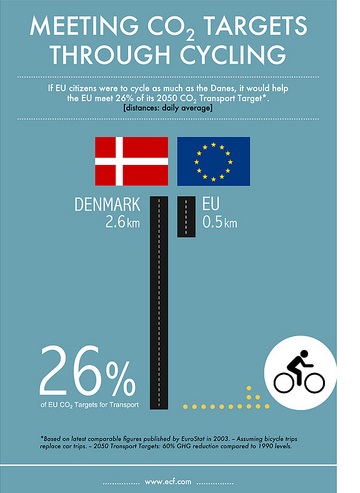
Investing in cycling to meet the EU's 2030 40% emissions target and energy security goals
 ECF’s aim, to get ‘more people cycling more often’, is a win-win situation for meeting both the target of a 40% emissions reduction by 2030 and the EU’s energy security goals. Making up a fifth of the EU’s greenhouse gas emissions, reducing emissions from the transport sector is key to meeting the 40% targets
ECF’s aim, to get ‘more people cycling more often’, is a win-win situation for meeting both the target of a 40% emissions reduction by 2030 and the EU’s energy security goals. Making up a fifth of the EU’s greenhouse gas emissions, reducing emissions from the transport sector is key to meeting the 40% targets
Why cycling matters
Our 2011 ‘Cycling more Often 2 cool down the planet’ study showed that if the EU-27 were to cycle as much as Denmark, this could meet up to 26% of the 2050 transport sector targets and would reduce the EU’s oil imports by 9% . This is in addition to benefits of active mobility such as better health, lowered road congestion and the unlocking of new public spaces
The heavy focus on improving technology through energy efficiency, rather than encouraging behavior shifts and avoiding unnecessary trips, is limiting the ability of the EU to meet these goals. Improving technology is a step in the right direction and it will help us to a certain extent, but it won’t be enough to reduce our energy dependence and emissions sufficiently.
Modal shift potential
What the EU needs is a modal shift away from fossil-fuel based forms of transport in favour of active mobility. Shifting transport away from car-use is realistic if governments start to create a level playing-field for cycling in the transport sector.
The potential for a modal shift is huge as 50% of all car trips are under 5km so they could feasibly be replaced by cycling. Cycling innovations, such as the electric bicycle, amplify this potential as they facilitate cycling; e-bike users are proven to cycle more often and over longer distances than their counterparts. Cargo bikes adds further weight to this argument, as 25% of urban deliveries could easily be made by bike.
Political commitment needed
While more and more cities are recognizing cycling as an affordable, effective and efficient solution, there is still work to be done at the political level. From a fiscal standpoint, the polluter pays principle must be applied to motorised transport. This would mean the phasing out of subsidies that create artificially high demand for cars, such as company cars. In terms of infrastructure, the needs of cyclists must be taken into account right from the beginning when allocating public space, building roads and maintaining existing infrastructure.
Removing the road allocation bias
Finally, there should be greater justice in road allocation with relation to modal share. For instance, in Berlin where there is a 15% cycling modal share only 3% of road space is dedicated to cycling. Cars, with 33% of the modal share, are allocated a huge 58%. This disparity reflects a bias towards cars when in many inner urban areas cycling is more efficient and less polluting.
This bias must be abandoned if we are to meet emissions reductions and energy security goals. If the EU starts to focus on a modal and behavioral shift rather than primarily technology improvement, cycling will have a fighting chance at helping the EU meet their goals.
This article was also published on CommentVisions as part of an online debate on the question: ‘In what ways can the EU achieve both the proposed 2030 40% emissions target and its energy security goals?’.
- Log in to post comments
Contact the author
Recent news!
Upcoming events
Contact Us
Avenue des Arts, 7-8
Postal address: Rue de la Charité, 22
1210 Brussels, Belgium









